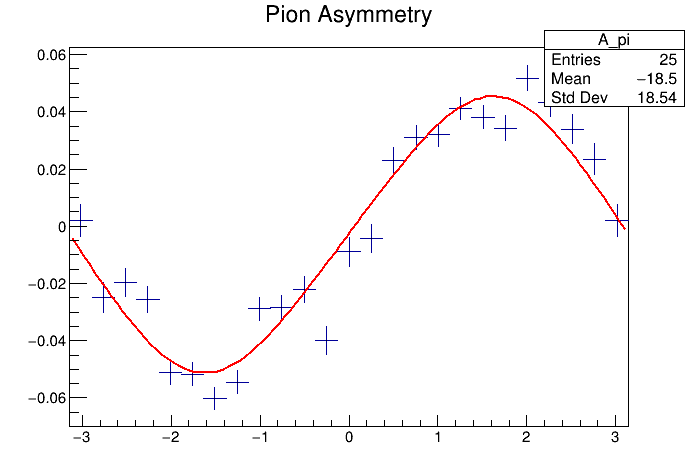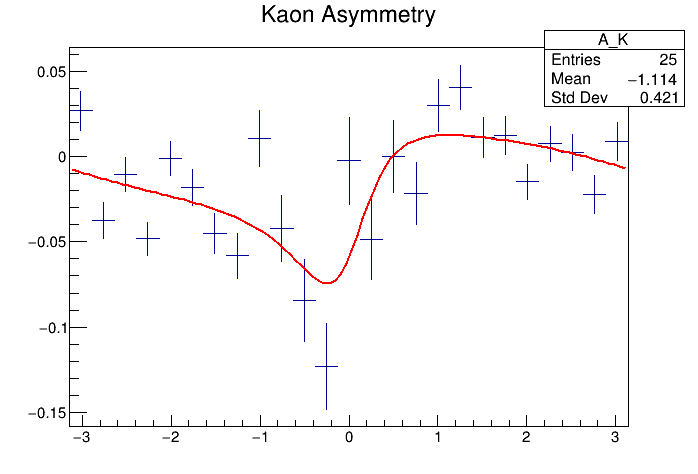Single Spin Asymmetry Analysis » History » Revision 10
« Previous |
Revision 10/23
(diff)
| Next »
Stephen Kay, 11/03/2022 05:06 PM
- Table of contents
- Single Spin Asymmetry Analysis
Single Spin Asymmetry Analysis¶
Resources¶
Stefan Diehl's DNP2022 Talk: attachment:5_Stefan_Diehl_V.pdf
Steve Wood's Slides (03/11/22): attachment:Polarization.pptx
Steve Wood's (old) Polarisation Spreadsheet: attachment:WienAngles.xlsx
Steve Wood's (old) HWP List: attachment:IHWP.txt
Overview¶
During the fall 2018 running of the Kaon-LT experiment, polarized beam was delivered to Hall B. According to Dave Gaskell, at the energy we ran at, the spin precession in the Hall C arc was such that we got nearly as much polarization as Hall B, so we had a polarization of about 85%. This means that, for hadron production out of the plane defined by the beam and scattered electron, we should see an asymmetry in the yield between the two beam helicity states. This asymmetry is known variously as the single spin asymmetry, σ LT', or the fifth structure function.
As a function of φ, the azimuthal angle about q, the asymmetry should vary as (A+Bsin(φ))/(1+Ccos(2φ)+Dcos(φ)) where the C and D terms come from the σ TT and σ LT modulations of the cross section.
References¶
Hall B paper exclusive pion production single spin asymmetries, Park et. al. 2008
How to add helicity to ROOT files.¶
The helicity of the beam potentially reversed every 1/30 of a second according to a pseudorandom sequence. The helicity signals delivered to the hall are delayed by 8*(1/30) second. This delayed helicity signal is recorded in several ADCs which are read each event. In order to extract the helicity and undo the delayed reporting of helicity, a recent version of `hcana` which includes the class `THcHelicity` is needed. In order to add the true beam helicity to each event in the root tree, make sure that the following are implemented in the replay script and analysis def file.
After the trigger apparatus is defined, add the following lines to the analysis script:
// Add helicity detector to trigger apparatus
THcHelicity* helicity = new THcHelicity("helicity","Helicity Detector");
TRG->AddDetector(helicity);In the def file (coin_production.def) add these lines:
block T.helicity.hel
block T.helicity.helrep
block T.helicity.mps
T.helicity.hel will be +/-1 indicating the actual helicity of the beam, event-by-event. If it is zero, then either the event was during the MPS (settling time between helicity reversals.) or the analyzer was unable to decode the helicity properly. helrep is the reported T.helicity.helrep which is delayed. T.helicity.mps is 1 if the event was during the MPS.
Tasks¶
- Get the history of the status of the Insertable Half Wave Plate (EPICS signal IGL1I00DI24_24M). The IHWP is a passive optical element on the injector laser table that reverses the helicity of the electron beam, but does not reverse the reported helicity. Experimental asymmetries will be reversed when the IHWP is in, so the analysis must reverse the asymmetries for runs when this IHWP was in. It is possible that the state of the IHWP was changed in the middle of one of runs. Any such runs need to be identified and analyzed specially.
- Get the history of Hall B beam polarization measurements. Translate these polarizations into Hall C polarizations.
- FIgure out how to bin and display results. Should asymmetries be presented as a function of t or θ hq (cm or lab). How finely can we bin in t or θ?
- For pion asymmetries. Determine accidental background. This asymmetry from accidental backgrounds should be zero, but this background will reduce or dilute the observed asymmetry.
- For Kaon asymmetries it is more complicated. As well as a dilution from accidentals, the radiative tail from exclusive pions misidentified as Kaons contributes to the observed Kaon asymmetries. The asymmetry from these pions will not be zero. In order to correct for this to get Kaon asymmetries, the accepted yield of the tail and its asymmetry needs to be determined.
- Determine if it is possible to get any meaningful asymmetries from the baryons beyond the Lambda.
Analysis Teaser¶
These two asymmetry plots were made from an analysis of all the Q 2 =3.0, W=2.32, x=0.40 data using a modified version of the `KaonYield_Q3W2Center.C` script. The pion asymmetry has a cut around the neutron missing mass, while the kaon asymmetry has a cut missing mass cut on the Lambda mass. The kaon asymmetry certainly has a pion contamination. All accepted t (or θ hq) are included. There is a 50% chance that the sign is correct. The asymmetries are fit with the above functional form. These asymmetries do not necessarily need to follow that form as each φ bin has a different t coverage range.


Updated by Stephen Kay about 3 years ago · 10 revisions